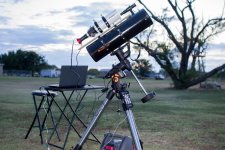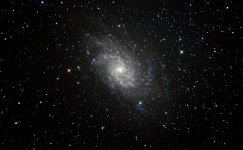You are using an out of date browser. It may not display this or other websites correctly.
You should upgrade or use an alternative browser.
You should upgrade or use an alternative browser.
Another Astrophoto...M33 Triangulum Galaxy
- Thread starter Dxer
- Start date
Not that I will ever try it, but I would love to see a picture of your setup and explanation of all the parts that goes into this.
My current setup looks like this

This is more or less an entry level setup. I have a Celestron Advanced VX mount with a 6" Newtonian type telescope.
The mount itself is the most important part of the rig. This is needed to find and track the objects in the sky. The tripod will rival most if not all high end tripods for photography use. The tripod is made of 2" stainless steel legs. Incredibly sturdy. Not exactly something you would want to carry around though. lol
The mount is computer controlled via the handset you see in the picture. Through the handset is where you tell your mount where you are and inputting time and date. Also this where you do your star alignments. When everything is completed, you just tell the mount what object you want to see and it will point to that object and track it.
The big tube is the main telescope and what I use for imaging with. It is a simple Newtonian. No lenses or any kind of glass is used the optical train. Light goes through the opening and reflects of a mirror at the other end of the tube. Bounces the light to a secondary mirror which then reflects the light into the focuser. This is where my Nikon camera gets attached.
The smaller telescope on top is part of my autoguider. Unless you are a perfect human being, this is unnecessary. But nobody is perfect.
I hope some of this makes sense. I am a beginner to say the least at this but I am having fun with it.
An awesome shot, and great set up, thanks for posting! I used to have a Celestron SLT130 telescope, great fun for relatively little money. Work & family meant I didn't get chance to use is as much as I used to, so I sold it however I know that one day, I will buy another 'scope.
Once you have tried looking through a telescope, you will spend every clear night after that just stood staring at the sky.
Once you have tried looking through a telescope, you will spend every clear night after that just stood staring at the sky.
I bought my gear through various vendors, ebay and AstroMart.
An 8" dob is a great telescope for visual use. But terrible for astrophotography. No way to track but by hand. So you will be extremely limited in exposures. A second or less. Also I don't know if there is enough back focus on the dob to allow you to focus with a DSLR. You might have to add a barlow in the optical train to achieve focus.
But what you can do with the dob is use a planetary camera like a Celestron NexImage 5 (which I have) or just modify a webcam and video capture the planet as it moves across the FOV. Then run the video through a program called Registax 6 and it will stack the individual frames of the video into a photo. You should be able to get stunning results with planets like the Moon, Jupiter and Saturn. You can also try the DSLR for video if your camera supports it. But the wide field of view using a DSLR will make the planet look pretty small.
So just get a t-ring and an adapter to fit your dob and you should be good to go.
An 8" dob is a great telescope for visual use. But terrible for astrophotography. No way to track but by hand. So you will be extremely limited in exposures. A second or less. Also I don't know if there is enough back focus on the dob to allow you to focus with a DSLR. You might have to add a barlow in the optical train to achieve focus.
But what you can do with the dob is use a planetary camera like a Celestron NexImage 5 (which I have) or just modify a webcam and video capture the planet as it moves across the FOV. Then run the video through a program called Registax 6 and it will stack the individual frames of the video into a photo. You should be able to get stunning results with planets like the Moon, Jupiter and Saturn. You can also try the DSLR for video if your camera supports it. But the wide field of view using a DSLR will make the planet look pretty small.
So just get a t-ring and an adapter to fit your dob and you should be good to go.
Thanks Steve! 
That 130 SLT is pretty good actually for the money. It's an AltAz mount but it does track. So astrophotography is possible with it if you decide to pick up another one. It won't allow for long exposures over 30 seconds though. But I have seen some pretty good pictures that others have taken with that scope.
That 130 SLT is pretty good actually for the money. It's an AltAz mount but it does track. So astrophotography is possible with it if you decide to pick up another one. It won't allow for long exposures over 30 seconds though. But I have seen some pretty good pictures that others have taken with that scope.

